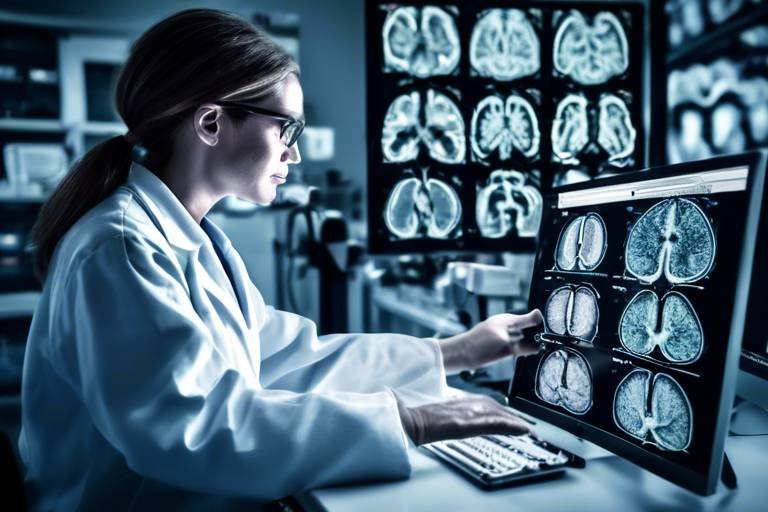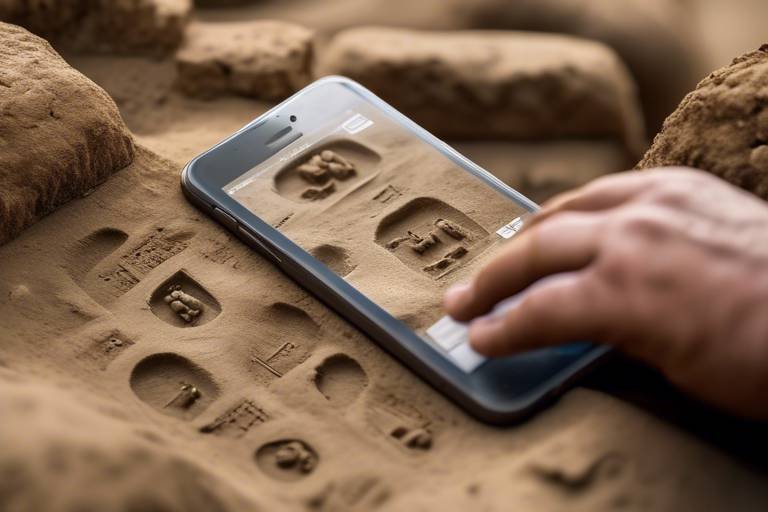How Technology is Advancing Neurological Research
The field of neurological research is undergoing a transformative revolution, largely fueled by cutting-edge technology. Imagine a world where understanding the intricate workings of the brain is not just a dream but a tangible reality. With innovations emerging at an unprecedented pace, we're not only reshaping our understanding of neurological disorders but also enhancing diagnostic and therapeutic techniques. This article dives deep into how technology is bridging the gap between complex brain functions and practical applications, enabling researchers and clinicians to unlock the mysteries of the mind.
Advancements in neuroimaging technologies, such as functional Magnetic Resonance Imaging (fMRI) and Positron Emission Tomography (PET) scans, have revolutionized our ability to visualize brain activity and structure. These tools provide invaluable insights into neurological disorders and cognitive functions, allowing researchers to see the brain in action. For instance, fMRI can capture the brain's response to stimuli in real-time, highlighting areas of activity that correlate with various cognitive tasks. This capability is crucial for understanding conditions like epilepsy, where pinpointing the origin of seizures can lead to more effective treatments.
Artificial Intelligence (AI) is making waves in the world of diagnostics, particularly in neurology. AI algorithms are increasingly being utilized to analyze complex neurological data, enhancing diagnostic accuracy and enabling early detection of conditions like Alzheimer’s and Parkinson’s disease. By processing vast amounts of data, these algorithms can identify subtle patterns that human eyes might miss. This not only speeds up the diagnostic process but also ensures that patients receive appropriate treatment much earlier in the disease progression.
Machine learning models are being trained on extensive datasets to identify patterns in neurological disorders. This approach is paving the way for personalized treatment plans and improved patient outcomes. For example, machine learning can analyze genetic information alongside imaging data to predict how a patient will respond to certain medications. This tailored approach is akin to having a bespoke suit made just for you—everything fits perfectly and is designed to meet your unique needs.
Employing predictive analytics allows researchers to anticipate disease progression and response to therapies. This proactive approach to patient care is akin to having a roadmap for navigating a complex journey. By understanding potential future scenarios, healthcare providers can tailor interventions to mitigate risks and enhance patient quality of life.
Integrating data from various sources, including genetic, imaging, and clinical data, enhances our understanding of neurological diseases. This holistic view supports the development of comprehensive treatment strategies. For instance, a combination of genetic markers and neuroimaging results can provide a clearer picture of a patient’s condition, leading to more effective management strategies.
Innovative neurotechnologies, such as brain-computer interfaces and neuromodulation devices, are transforming treatment options for neurological conditions. These technologies offer new hope for patients with limited therapeutic responses, providing alternative avenues for treatment. Imagine controlling a computer with your thoughts or using a device that stimulates specific brain regions to alleviate symptoms—these are no longer fantasies but realities being explored in labs around the world.
Wearable devices are becoming essential tools in neurological research. They enable continuous monitoring of patients, providing real-time data that can inform clinical decisions and research studies. This technology empowers patients to take charge of their health, akin to having a personal trainer who monitors your progress and adjusts your regimen accordingly.
Continuous data collection through wearables allows researchers to track symptoms and responses to treatment. This facilitates a deeper understanding of neurological conditions in everyday environments, capturing the nuances of how these disorders impact daily life. It's like having a window into a patient’s world, revealing insights that traditional clinical visits might overlook.
Wearable technologies promote patient engagement and adherence to treatment protocols. By empowering individuals to monitor their health, patients become active participants in their care, leading to better outcomes. Think of it as a partnership where both the patient and healthcare provider work together towards a common goal—improved health and well-being.
The rise of telemedicine has expanded access to neurological care, allowing patients to consult specialists remotely. This is particularly beneficial for those living in rural areas or those who have mobility issues. Telemedicine breaks down geographical barriers, making it easier for patients to receive timely and specialized care.
Remote consultations provide convenience and flexibility for patients. They ensure that individuals receive timely care without the hassle of travel, which can be exhausting for those with neurological conditions. This flexibility can significantly reduce the burden on healthcare facilities, allowing them to allocate resources more efficiently.
Virtual clinical trials leverage technology to recruit participants and collect data. This innovative approach streamlines the research process and enables faster development of new treatments for neurological conditions. By making participation easier, virtual trials can attract a more diverse participant pool, ultimately leading to more robust findings.
- What are the benefits of neuroimaging techniques? Neuroimaging techniques allow researchers to visualize brain activity and structure, leading to better understanding and treatment of neurological disorders.
- How does AI improve diagnostic accuracy? AI analyzes complex data and identifies patterns that may be missed by humans, enabling earlier detection of conditions like Alzheimer's and Parkinson's.
- What role do wearable devices play in neurological research? Wearable devices enable continuous monitoring of symptoms, promoting patient engagement and providing real-time data for research.
- How has telemedicine changed neurological care? Telemedicine has expanded access to care, allowing patients to consult specialists remotely and participate in clinical trials without geographical constraints.

Neuroimaging Techniques
Advancements in neuroimaging technologies have truly revolutionized our understanding of the brain. Techniques such as functional Magnetic Resonance Imaging (fMRI) and Positron Emission Tomography (PET) scans have opened up new avenues for researchers and clinicians alike. These technologies allow us to visualize brain activity and structure with unprecedented precision, providing invaluable insights into various neurological disorders.
Imagine being able to see your brain in action, like watching a live performance of an orchestra where each instrument represents a different brain function. With neuroimaging, researchers can pinpoint which areas of the brain are engaged during specific tasks, leading to breakthroughs in understanding conditions like Alzheimer's or Parkinson's disease. This ability to visualize brain activity in real time is akin to having a backstage pass to the inner workings of the mind.
Here’s a brief overview of some key neuroimaging techniques:
- fMRI: This technique measures brain activity by detecting changes in blood flow. It’s particularly useful for mapping brain functions and understanding cognitive processes.
- PET scans: These scans use radioactive tracers to visualize metabolic processes in the brain, helping to identify abnormalities associated with various neurological conditions.
- CT scans: While primarily used for structural imaging, CT scans can provide crucial information about brain injuries and diseases.
Each of these techniques brings its own strengths to the table. For instance, fMRI is non-invasive and provides excellent spatial resolution, making it ideal for studying brain function. On the other hand, PET scans offer insights into metabolic activity, which can be crucial for diagnosing certain conditions early on. By integrating findings from these various imaging modalities, researchers can develop a more comprehensive understanding of neurological disorders.
Moreover, the evolution of neuroimaging technology has also led to improved diagnostic capabilities. For example, in the past, diagnosing conditions like multiple sclerosis or epilepsy relied heavily on clinical evaluations and patient histories. Now, with advanced imaging techniques, clinicians can visualize lesions, abnormal brain activity, and other critical indicators that facilitate accurate diagnoses.
As we continue to enhance these imaging technologies, the potential for discovering new therapeutic targets and developing innovative treatments grows exponentially. The brain, once a mysterious black box, is gradually revealing its secrets, thanks to the power of neuroimaging. This ongoing research not only enhances our understanding of the brain but also improves the quality of life for patients suffering from neurological disorders.
- What is fMRI and how does it work?
fMRI stands for functional Magnetic Resonance Imaging. It measures brain activity by detecting changes in blood flow, allowing researchers to see which parts of the brain are active during specific tasks. - Are neuroimaging techniques safe?
Yes, most neuroimaging techniques, such as fMRI and CT scans, are considered safe and non-invasive. However, PET scans involve exposure to small amounts of radioactive material, which is carefully monitored. - How do neuroimaging techniques help in diagnosing neurological disorders?
These techniques provide visual evidence of brain structure and function, which can reveal abnormalities associated with various neurological conditions, leading to more accurate diagnoses.

Artificial Intelligence in Diagnostics
Artificial Intelligence (AI) is not just a buzzword; it's a game-changer in the field of diagnostics, particularly in neurology. Imagine having a super-smart assistant that can sift through mountains of data, identifying patterns and anomalies that even the sharpest human mind might miss. That's exactly what AI is doing! By leveraging advanced algorithms and machine learning techniques, researchers and clinicians are enhancing diagnostic accuracy and enabling early detection of conditions like Alzheimer’s and Parkinson’s disease.
One of the most exciting aspects of AI in diagnostics is its ability to analyze complex neurological data at lightning speed. For instance, traditional diagnostic methods often rely on subjective assessments and can be time-consuming. In contrast, AI algorithms can process vast datasets—from neuroimaging results to genetic information—in a fraction of the time. This not only speeds up the diagnostic process but also reduces the likelihood of human error, leading to more reliable outcomes.
Take, for example, the use of AI in interpreting brain scans. With the help of machine learning, AI systems can be trained to recognize subtle changes in brain structures that may indicate the early onset of neurological disorders. This capability is particularly crucial for conditions like Alzheimer’s, where early intervention can significantly alter the disease's trajectory. The potential for AI to transform how we diagnose and treat neurological disorders is immense, and it's already making waves in clinical settings.
Machine learning, a subset of AI, is particularly adept at identifying patterns in data. In the context of neurology, this means that researchers can train models on extensive datasets to recognize the early signs of various neurological disorders. This is not just about crunching numbers; it's about understanding the intricate web of interactions that occur in the brain. By analyzing data from different sources—such as imaging studies, genetic profiles, and patient histories—machine learning can pave the way for personalized treatment plans that cater to individual patient needs.
Imagine if doctors could predict how a disease would progress in a specific patient. With predictive analytics, this is becoming a reality. By employing sophisticated algorithms, researchers can analyze historical data to forecast disease progression and response to therapies. This predictive power allows for more proactive and tailored approaches to patient care, ensuring that interventions are not only timely but also effective. As a result, patients can receive treatments that are specifically designed for their unique neurological profiles, ultimately leading to better health outcomes.
Integrating data from various sources enhances our understanding of neurological diseases and supports the development of comprehensive treatment strategies. By combining genetic, imaging, and clinical data, researchers can create a more holistic view of a patient’s condition. This integration is essential for identifying correlations between different factors and understanding how they contribute to neurological disorders. The synergy of diverse data types enables a more informed approach to diagnostics, ensuring that no stone is left unturned in the quest for effective treatments.
As we stand on the brink of this technological revolution, the potential for AI in diagnostics is vast and exciting. The integration of machine learning and predictive analytics is not just a trend; it's a fundamental shift in how we approach neurological health. With continued advancements in technology, we can expect to see even more groundbreaking innovations that will further enhance our understanding and treatment of neurological disorders.
- What role does AI play in diagnosing neurological disorders? AI enhances diagnostic accuracy by analyzing complex data and identifying patterns that may indicate neurological conditions.
- How does machine learning improve patient outcomes? Machine learning allows for personalized treatment plans by recognizing individual patterns in neurological disorders.
- Can AI predict disease progression? Yes, predictive analytics can forecast how a disease will progress, enabling timely and tailored interventions.
- What types of data are integrated for better diagnostics? Data from genetic profiles, neuroimaging, and clinical histories are combined to create a comprehensive understanding of a patient's condition.

Machine Learning Applications
Machine learning is not just a buzzword; it’s a game changer in the field of neurological research. Imagine a world where computers can sift through mountains of data faster than a human can blink, identifying patterns that could take years for specialists to discover. That’s precisely what machine learning is doing for us in understanding neurological disorders. By training sophisticated algorithms on vast datasets, researchers can uncover hidden correlations between symptoms, genetic markers, and even environmental factors.
One of the most exciting aspects of machine learning in neurology is its ability to create personalized treatment plans. For instance, consider a patient diagnosed with Alzheimer’s disease. Traditionally, treatment options were often one-size-fits-all, but with the insights gained from machine learning, doctors can tailor therapies based on individual patient data. This means that treatments can be adjusted in real-time, leading to better outcomes and improved quality of life for patients.
Moreover, the application of machine learning extends beyond just diagnosis and treatment. It also plays a crucial role in predictive modeling. By analyzing historical data, machine learning models can forecast disease progression and potential responses to various therapies. This predictive capability allows healthcare providers to intervene earlier and more effectively, reducing the overall burden of neurological diseases on patients and healthcare systems alike.
To illustrate this further, let’s look at a simple example of how machine learning can be applied in neurology:
| Application | Description | Benefits |
|---|---|---|
| Early Detection | Using algorithms to analyze brain scans for early signs of disorders like Alzheimer's. | Increased chances of successful intervention. |
| Customized Treatment Plans | Identifying the most effective treatment based on patient-specific data. | Improved patient outcomes and reduced side effects. |
| Symptom Tracking | Monitoring patient symptoms through wearable devices and analyzing the data. | Real-time adjustments to treatment strategies. |
As we delve deeper into the realm of machine learning, it’s clear that the integration of this technology into neurological research is not just a trend; it’s the future. The potential for enhanced patient outcomes is enormous, and the ongoing research in this area promises to unlock even more possibilities. So, next time you hear about machine learning, think about how it's not just changing technology but also transforming lives, one brain at a time.
- What is machine learning?
Machine learning is a subset of artificial intelligence that enables systems to learn from data and improve their performance over time without being explicitly programmed.
- How does machine learning help in neurology?
Machine learning assists in identifying patterns in neurological data, facilitating early diagnosis, personalized treatment plans, and predictive analytics for disease progression.
- Are there any risks associated with machine learning in healthcare?
While machine learning offers significant benefits, there are concerns regarding data privacy, algorithm bias, and the need for continuous validation to ensure accuracy.

Predictive Analytics
Predictive analytics is like having a crystal ball for the future of neurological health. Imagine being able to foresee the progression of a disease before it fully manifests. This is not just a dream; it's becoming a reality thanks to the integration of advanced statistical techniques and machine learning algorithms. By analyzing vast amounts of data, researchers can identify trends and patterns that were previously hidden, allowing for a more proactive approach to patient care.
At its core, predictive analytics leverages historical data to make informed predictions about future outcomes. In the context of neurological conditions, this means that doctors can anticipate how a patient's disease may evolve over time and adjust treatment plans accordingly. For instance, predicting the onset of symptoms in conditions like Alzheimer's or Parkinson's can lead to earlier interventions, which are often critical in managing these diseases.
To put it into perspective, consider the analogy of weather forecasting. Just as meteorologists use historical weather patterns to predict future conditions, neurologists can use patient data to forecast disease progression. This can include factors such as genetic predispositions, lifestyle choices, and even environmental influences. The combination of these elements creates a comprehensive picture that helps healthcare providers tailor their approaches.
Moreover, predictive analytics is not just about identifying risks; it's also about enhancing the quality of life for patients. By understanding how a disease might progress, healthcare providers can implement preventive measures that are personalized for each patient. For example, if predictive models suggest a high likelihood of rapid cognitive decline, clinicians can offer cognitive therapies and lifestyle modifications earlier in the treatment process.
In a nutshell, predictive analytics is revolutionizing the landscape of neurological research and treatment. It empowers healthcare professionals to move from reactive to proactive care, ultimately improving patient outcomes. The future of neurology is not just about treating symptoms; it's about anticipating them and taking action before they become debilitating.
- What is predictive analytics in neurology?
Predictive analytics in neurology refers to the use of statistical algorithms and machine learning techniques to analyze patient data and forecast disease progression and treatment responses.
- How does predictive analytics improve patient care?
By anticipating disease progression, predictive analytics allows healthcare providers to tailor treatments and interventions, leading to better management of neurological conditions.
- What types of data are used in predictive analytics?
Data can include genetic information, clinical history, neuroimaging results, and lifestyle factors, all of which contribute to a comprehensive understanding of a patient's health.
- Can predictive analytics prevent neurological diseases?
While it cannot prevent diseases outright, predictive analytics can help identify at-risk individuals and implement early interventions that may slow disease progression.

Data Integration Techniques
In the realm of neurological research, are proving to be game-changers. By amalgamating diverse data sources—such as genetic information, neuroimaging results, and clinical assessments—researchers can gain a holistic view of neurological disorders. This multifaceted approach not only enhances our understanding of complex conditions but also supports the development of more effective treatment strategies. Imagine trying to solve a jigsaw puzzle; each piece represents a different aspect of a patient's health. Alone, each piece may be intriguing, but when combined, they create a clearer picture of the overall health landscape.
One of the most significant advancements in data integration is the use of advanced algorithms and software platforms that can handle large datasets efficiently. These technologies facilitate the merging of various data types, thus enabling researchers to identify correlations and trends that would otherwise remain hidden. For instance, integrating neuroimaging data with genetic profiles can reveal how specific genetic markers influence brain structure and function, leading to more targeted therapies.
Moreover, the integration of data from electronic health records (EHRs) provides a comprehensive view of patient history, medication adherence, and treatment outcomes. This wealth of information allows for the identification of patterns that can inform clinical decision-making. Researchers can utilize these insights to tailor interventions based on individual patient profiles, ultimately enhancing treatment efficacy.
To illustrate the impact of data integration techniques, consider the following table that summarizes the types of data commonly integrated in neurological research:
| Data Type | Description | Importance |
|---|---|---|
| Genetic Data | Information about genetic variations and mutations | Identifies hereditary factors influencing neurological disorders |
| Neuroimaging Data | Brain scans such as MRI and PET | Visualizes brain structure and activity, aiding diagnosis |
| Clinical Data | Patient history, symptoms, and treatment responses | Informs treatment decisions and outcomes |
| Wearable Device Data | Real-time monitoring of symptoms and behaviors | Provides ongoing insights into patient health |
As we continue to harness the power of data integration, the potential for breakthroughs in neurological research becomes increasingly evident. The synergy created by combining various data types not only enriches our understanding of neurological conditions but also paves the way for innovative treatment approaches. In this fast-paced digital age, leveraging technology to integrate data effectively is not just beneficial; it is essential for advancing our knowledge and improving patient care.
- What is data integration in neurological research?
Data integration involves combining various types of data, such as genetic, neuroimaging, and clinical information, to create a comprehensive understanding of neurological disorders. - Why is data integration important?
It enhances our understanding of complex neurological conditions and supports the development of personalized treatment strategies. - How does technology aid in data integration?
Advanced algorithms and software platforms facilitate the efficient merging of large datasets, allowing researchers to identify significant patterns and correlations.

Neurotechnology Innovations
Neurotechnology is at the forefront of revolutionizing how we understand and treat neurological conditions. Imagine being able to control a computer or a prosthetic limb just by thinking about it! This is not science fiction; it’s a reality made possible by innovations like brain-computer interfaces (BCIs) and neuromodulation devices. These technologies are not only enhancing our understanding of the brain but also offering new therapeutic options for patients who have previously had limited responses to traditional treatments.
Brain-computer interfaces (BCIs) are particularly fascinating. They create a direct communication pathway between the brain and external devices, allowing individuals to control these devices through their thoughts. This can be life-changing for patients with severe motor disabilities. For instance, a person with paralysis can manipulate a robotic arm or a computer cursor simply by thinking about the movement. This technology opens up a world of possibilities for independence and improved quality of life.
On the other hand, neuromodulation devices, such as deep brain stimulators, work by delivering electrical impulses to specific brain regions. This technique has shown promise in treating conditions like Parkinson’s disease and chronic pain. By modulating the brain's activity, these devices can alleviate symptoms and improve patient outcomes. The ability to fine-tune these devices means that treatments can be personalized, catering to the unique needs of each patient.
Moreover, the integration of these technologies with artificial intelligence is paving the way for even more advanced applications. For example, AI can analyze data collected from BCIs and neuromodulation devices to optimize treatment plans in real-time. This synergy between neurotechnology and AI not only enhances the effectiveness of treatments but also provides researchers with invaluable data to further understand the complexities of the human brain.
As we look to the future, the potential for neurotechnology innovations is immense. Researchers are exploring new frontiers, such as non-invasive brain stimulation techniques and advanced neurofeedback systems. These developments could lead to breakthroughs in treating a variety of neurological disorders, from epilepsy to depression. The journey of understanding and manipulating the brain is just beginning, and the impact of these innovations could be profound.
In summary, neurotechnology is transforming the landscape of neurological research and treatment. With each new innovation, we are not only gaining insights into the brain's workings but also empowering patients to reclaim control over their lives. The intersection of technology and neuroscience is a thrilling space to watch, and it promises to reshape our understanding of what is possible in the realm of neurological care.
- What are brain-computer interfaces?
BCIs are devices that create a direct communication pathway between the brain and external devices, allowing control through thought. - How do neuromodulation devices work?
These devices deliver electrical impulses to specific brain regions to modulate activity and alleviate symptoms of neurological conditions. - Can neurotechnology help with mental health issues?
Yes, innovations like non-invasive brain stimulation are being explored for treating conditions such as depression and anxiety. - What role does artificial intelligence play in neurotechnology?
AI analyzes data from neurotechnology devices to optimize treatment plans and enhance understanding of neurological disorders.

Wearable Health Devices
In recent years, have emerged as groundbreaking tools in the realm of neurological research. These devices, which range from smartwatches to specialized sensors, have become integral in monitoring various health metrics in real time. Imagine having a personal assistant that not only tracks your daily steps but also provides insights into your neurological health! This is exactly what these wearables offer—an unprecedented level of engagement and monitoring that can significantly enhance our understanding of neurological conditions.
One of the most exciting aspects of wearable health devices is their ability to facilitate real-time monitoring of patients. By continuously collecting data on vital signs, activity levels, and even sleep patterns, these devices allow researchers and healthcare providers to gain a deeper understanding of how neurological conditions manifest in everyday life. For instance, a smartwatch equipped with sensors can track heart rate variability, which has been linked to stress and anxiety—two factors that can exacerbate neurological disorders. This continuous stream of data can lead to more accurate assessments and timely interventions.
Moreover, wearable technologies promote patient engagement in a way that traditional methods cannot. Patients are empowered to take an active role in managing their health, which can lead to better adherence to treatment protocols. For example, many wearable devices come with mobile applications that allow users to set health goals, receive reminders for medication, and even log symptoms. This interactive approach not only helps patients feel more in control of their health but also provides researchers with valuable data on how individuals respond to treatments over time.
To illustrate the impact of wearable health devices on neurological research, consider the following table that outlines some key features and benefits:
| Device Type | Key Features | Benefits for Neurological Research |
|---|---|---|
| Smartwatches | Heart rate monitoring, activity tracking, sleep analysis | Real-time health data, enhanced patient engagement |
| EEG Headsets | Brainwave monitoring, stress level assessment | Insights into cognitive function, tracking neurological changes |
| Wearable Sensors | Movement tracking, posture correction | Understanding motor function, rehabilitation support |
As we delve deeper into the world of wearable health devices, it becomes clear that these innovations are not just gadgets; they are lifelines that connect patients, researchers, and healthcare providers in a dynamic network of information. The data collected from these devices can lead to groundbreaking discoveries in understanding disease progression and treatment efficacy, ultimately paving the way for more personalized and effective care.
In conclusion, wearable health devices represent a significant leap forward in neurological research. They not only enhance our ability to monitor patients but also foster greater involvement from individuals in their own healthcare journeys. As technology continues to evolve, the potential for these devices to transform the landscape of neurology is truly exciting.
- What types of wearable health devices are available for neurological research?
There are various types, including smartwatches, EEG headsets, and specialized sensors designed to monitor different health metrics relevant to neurological conditions.
- How do wearable devices improve patient engagement?
Wearable devices empower patients by allowing them to track their health metrics, set goals, and receive reminders, which fosters a sense of control over their health.
- Can wearable health devices replace traditional medical consultations?
No, while they provide valuable data and insights, they are meant to complement traditional healthcare practices, not replace them.

Real-Time Monitoring
Imagine having a personal assistant that never sleeps, constantly keeping an eye on your health and well-being. That's the beauty of through wearable devices in neurological research. These innovative gadgets, ranging from smartwatches to specialized sensors, are revolutionizing how we understand and manage neurological conditions. By continuously collecting data, they provide a window into the patient's daily life, capturing fluctuations in symptoms that would otherwise go unnoticed.
One of the most significant advantages of real-time monitoring is the ability to track symptom patterns in a natural setting. For instance, a patient with epilepsy might wear a device that records their physiological data, such as heart rate and movement. This data can reveal triggers that lead to seizures, allowing both patients and healthcare providers to better understand and manage the condition. It’s like having a detective on the case, piecing together clues to solve the mystery of what influences a patient's health.
Moreover, real-time monitoring facilitates immediate feedback regarding treatment efficacy. If a patient starts a new medication, wearable devices can provide insights into how their body is responding. Are their symptoms decreasing? Are there any adverse reactions? This immediate feedback loop can empower patients, giving them the confidence to engage actively in their treatment plans. It fosters a sense of partnership between patients and healthcare providers, where both parties can make informed decisions based on real-time data.
In addition to enhancing patient care, real-time monitoring also plays a crucial role in research. By aggregating data from multiple patients, researchers can identify trends and correlations that would be impossible to detect in a traditional clinical setting. For example, a study might reveal that certain environmental factors, like temperature or stress levels, correlate with an increase in migraine frequency. This kind of information is invaluable, as it can lead to new treatment strategies that are more personalized and effective.
To illustrate the impact of real-time monitoring, consider the following table that highlights key benefits:
| Benefit | Description |
|---|---|
| Continuous Data Collection | Allows for tracking of symptoms and treatment responses in real-time. |
| Improved Patient Engagement | Empowers patients to take an active role in managing their health. |
| Enhanced Research Opportunities | Facilitates the discovery of trends and correlations in large datasets. |
In conclusion, real-time monitoring is not just a technological advancement; it's a transformative approach that is reshaping the landscape of neurological research and patient care. By providing continuous insights into a patient's health, these devices are paving the way for more personalized and effective treatment strategies. The future of neurology is bright, and it’s powered by the data collected from our everyday lives.
- What types of wearable devices are used for real-time monitoring in neurology?
Wearable devices can include smartwatches, fitness trackers, and specialized medical sensors designed to monitor specific neurological conditions. - How does real-time monitoring benefit patients?
Patients gain immediate feedback on their symptoms and treatment responses, allowing for more informed decisions and active participation in their care. - Can real-time monitoring help in research?
Yes, it enables researchers to collect large datasets that reveal trends and correlations, ultimately leading to improved treatment strategies.

Patient Engagement
In the evolving landscape of neurological research, has emerged as a cornerstone for successful treatment outcomes. With the advent of wearable technologies, patients are no longer passive recipients of care; instead, they are becoming active participants in their health journey. Imagine being able to track your symptoms in real-time, sharing that data with your healthcare provider, and having a say in your treatment plan. This level of involvement is not just empowering; it can lead to significantly better health outcomes.
Wearable devices, such as smartwatches and fitness trackers, allow patients to monitor various health metrics, including heart rate, sleep patterns, and even neurological symptoms like tremors or mood fluctuations. This continuous stream of data can be a game-changer. For instance, if a patient notices a pattern in their symptoms that correlates with their medication schedule, they can discuss this with their doctor and adjust their treatment accordingly. This collaborative approach fosters a sense of ownership over one’s health, making patients feel more connected to their treatment.
Moreover, engaging patients through technology enhances their understanding of their neurological conditions. Many wearables come with companion apps that provide educational resources, symptom tracking features, and even reminders for medication. This integration of education and technology not only keeps patients informed but also encourages adherence to treatment protocols. When individuals understand the "why" behind their treatment, they are more likely to stick to it.
However, it’s essential to recognize that patient engagement goes beyond just technology. It involves creating a supportive environment where patients feel comfortable sharing their experiences and concerns. Healthcare providers play a vital role in this process. By fostering open communication, they can encourage patients to voice their thoughts and feelings about their treatment. This two-way street of information is crucial for tailoring interventions that truly meet the needs of each individual.
In summary, patient engagement in neurological research is a dynamic interplay between technology and human connection. As wearables continue to evolve, they will undoubtedly enhance our understanding of neurological conditions and improve patient outcomes. The more involved patients are in their care, the better the chances of achieving successful treatment results. So, let's embrace this shift towards a more engaged and informed patient population!
- What are wearable health devices? Wearable health devices are electronic devices worn on the body that monitor health metrics such as heart rate, activity levels, and neurological symptoms.
- How do wearable devices improve patient engagement? They allow patients to track their symptoms in real-time, share data with healthcare providers, and participate actively in their treatment plans.
- Can wearable technology help in diagnosing neurological conditions? Yes, continuous monitoring can provide valuable data that aids in early detection and diagnosis of neurological disorders.
- What role do healthcare providers play in patient engagement? Healthcare providers facilitate open communication, encourage patient participation, and tailor treatments based on patient feedback and data.

Telemedicine in Neurology
In recent years, telemedicine has emerged as a game-changer in the field of neurology. Imagine being able to consult a top neurologist from the comfort of your own home, bypassing long waits and travel hassles. This innovative approach not only enhances accessibility but also ensures that patients receive timely care, which is crucial for managing neurological conditions. The beauty of telemedicine lies in its ability to connect patients with specialists, regardless of geographical barriers, making it a vital resource in today’s healthcare landscape.
The rise of telemedicine in neurology has opened up a world of possibilities. Patients can now schedule remote consultations where they can discuss their symptoms, receive diagnoses, and even adjust treatment plans without stepping foot in a clinic. This convenience is a huge relief for individuals with mobility issues or those living in remote areas. Moreover, telemedicine reduces the burden on healthcare facilities, allowing them to allocate resources more efficiently. This shift is particularly important in neurology, where timely intervention can significantly impact patient outcomes.
One of the most exciting aspects of telemedicine is the advent of virtual clinical trials. These trials leverage technology to recruit participants and collect data in real-time, streamlining the research process. Patients can participate from anywhere, making it easier to gather diverse data sets that are crucial for understanding various neurological conditions. This not only accelerates the development of new treatments but also enhances the quality of research by ensuring that a broader range of participants can contribute their experiences.
However, it’s important to recognize that telemedicine is not without its challenges. Issues such as internet connectivity, privacy concerns, and the need for digital literacy can hinder some patients from fully benefiting from this technology. Nevertheless, the advantages far outweigh the drawbacks. As technology continues to evolve, we can expect telemedicine to become even more integrated into neurological care, making it a staple in the treatment landscape.
In summary, telemedicine is reshaping the way we approach neurological care, offering unprecedented access to specialists and facilitating innovative research. As we move forward, embracing these technological advancements will be essential in improving patient outcomes and enhancing the overall healthcare experience.
- What is telemedicine in neurology? Telemedicine in neurology refers to the use of technology to provide remote consultations, diagnoses, and treatment plans for patients with neurological conditions.
- How does telemedicine benefit patients? It offers convenience, reduces travel time, ensures timely care, and allows for participation in virtual clinical trials.
- Are there any challenges associated with telemedicine? Yes, challenges include internet connectivity issues, privacy concerns, and the need for patients to be comfortable with technology.

Remote Consultations
In today's fast-paced world, have become a game changer in the field of neurology. Imagine being able to connect with a specialist from the comfort of your home, bypassing the long commute and waiting times typically associated with in-person visits. This convenience is not just a luxury; it’s transforming how patients receive care. By leveraging video conferencing technology, patients can easily discuss their symptoms, treatment plans, and any concerns with neurologists, making healthcare more accessible than ever before.
The benefits of remote consultations are numerous. First and foremost, they provide flexibility. Patients can schedule appointments that fit their busy lives, which is particularly beneficial for those who may have difficulty traveling due to their condition. Moreover, remote consultations significantly reduce the burden on healthcare facilities, freeing up valuable resources for patients who require in-person care. This shift is especially crucial in times of public health crises, where minimizing physical contact is essential.
Additionally, remote consultations can enhance the quality of care. Neurologists can review patient history and diagnostic data in real-time, ensuring that they have all the necessary information at their fingertips. This immediacy allows for more informed decision-making and, ultimately, better patient outcomes. For instance, a neurologist can quickly adjust medication dosages based on a patient's reported side effects discussed during a video call.
However, there are challenges to consider. Not all patients may be comfortable with technology, and issues such as poor internet connectivity can hinder the effectiveness of remote consultations. To address these concerns, healthcare providers are increasingly offering training sessions for patients to familiarize them with the technology before their appointments. This proactive approach ensures that everyone can benefit from the convenience of remote care.
To summarize, remote consultations are revolutionizing the field of neurology by:
- Enhancing accessibility and convenience for patients
- Reducing the strain on healthcare facilities
- Improving the quality of care through real-time data access
- Providing tailored support to help patients navigate technology
As we continue to embrace technological advancements in healthcare, remote consultations will undoubtedly play a pivotal role in shaping the future of neurological care. They not only empower patients but also create a more efficient system for healthcare providers, ultimately leading to improved health outcomes.
- What technology do I need for a remote consultation?
Most remote consultations require a device with a camera and microphone, such as a smartphone, tablet, or computer, along with a stable internet connection. - Are remote consultations covered by insurance?
Coverage for remote consultations varies by insurance provider. It's best to check with your insurance company to understand your benefits. - Can I receive prescriptions during a remote consultation?
Yes, neurologists can prescribe medications during remote consultations if deemed necessary.

Virtual Clinical Trials
In recent years, have emerged as a groundbreaking approach to conducting research in the field of neurology. Imagine being able to participate in a clinical trial from the comfort of your own home, without the need for frequent hospital visits. This innovative method not only increases accessibility for patients but also enhances the efficiency of the research process. Virtual trials leverage technology to recruit participants, collect data, and monitor outcomes in real-time, making them a game-changer in the realm of neurological research.
One of the most significant advantages of virtual clinical trials is the ability to reach a broader and more diverse participant pool. Traditional trials often face challenges in recruitment due to geographical limitations, but with virtual trials, patients from various locations can easily join. This diversity is crucial, as it allows researchers to gather data that is more representative of the general population, ultimately leading to findings that are more applicable to a wider range of individuals.
Moreover, the use of digital platforms enables researchers to collect data more efficiently. Participants can report symptoms, side effects, and treatment responses through user-friendly applications or online surveys. This real-time data collection not only accelerates the research timeline but also allows for immediate adjustments to the study protocols if necessary. For instance, if a particular treatment shows promising results, researchers can quickly modify the trial parameters to explore that avenue further.
Another key aspect of virtual clinical trials is the enhanced patient engagement they foster. Patients often feel more empowered when they can actively participate in their treatment journey. With virtual trials, they can easily access educational resources, communicate with researchers, and stay informed about their progress. This level of engagement can lead to improved adherence to treatment protocols and a greater sense of ownership over their health.
Here’s a brief overview of the components that define virtual clinical trials:
| Component | Description |
|---|---|
| Recruitment | Utilizing online platforms to reach potential participants globally. |
| Data Collection | Real-time tracking of symptoms and treatment responses via apps. |
| Patient Engagement | Empowering patients through access to information and direct communication. |
| Monitoring | Continuous oversight of participant progress and study compliance. |
Despite the numerous benefits, virtual clinical trials are not without their challenges. Issues such as technology access, internet connectivity, and participant familiarity with digital tools can pose hurdles. However, as technology continues to advance and become more integrated into daily life, these barriers are gradually diminishing. Researchers are also working on strategies to support participants who may face difficulties, ensuring that no one is left behind in this digital evolution.
In conclusion, virtual clinical trials represent a significant shift in how neurological research is conducted. By harnessing the power of technology, these trials not only enhance accessibility and efficiency but also empower patients, making them active participants in their healthcare journey. As we move forward, it is crucial to embrace this innovative approach and continue refining it to maximize its potential in advancing our understanding of neurological conditions.
- What are virtual clinical trials? Virtual clinical trials are studies conducted using digital tools that allow participants to engage from their homes, facilitating data collection and monitoring without the need for physical visits.
- How do virtual trials improve patient recruitment? They eliminate geographical barriers, allowing patients from various locations to participate, leading to a more diverse participant pool.
- What challenges do virtual trials face? Potential challenges include technology access, internet connectivity issues, and the need for participants to be comfortable with digital tools.
- Can patients communicate with researchers during virtual trials? Yes, virtual trials often include platforms for direct communication, enhancing patient engagement and support.
Frequently Asked Questions
- What are neuroimaging techniques and how do they help in neurological research?
Neuroimaging techniques, such as fMRI and PET scans, allow researchers to visualize the brain's activity and structure. These technologies have transformed our understanding of neurological disorders by providing insights into how the brain functions, revealing abnormalities, and aiding in the diagnosis of conditions like Alzheimer's and Parkinson's disease.
- How is artificial intelligence being used in diagnosing neurological disorders?
Artificial intelligence (AI) is being utilized to analyze complex neurological data, which enhances diagnostic accuracy. AI algorithms can sift through vast amounts of information to identify patterns that may not be visible to the human eye, enabling earlier detection of diseases and more personalized treatment plans.
- What role does machine learning play in neurological research?
Machine learning plays a critical role by training models on large datasets to uncover patterns in neurological disorders. This technology is paving the way for tailored treatment plans, improving patient outcomes by predicting responses to therapies based on individual data.
- Can predictive analytics really anticipate disease progression?
Yes, predictive analytics can anticipate disease progression by analyzing historical data and recognizing trends. This allows researchers and clinicians to take proactive measures in treatment, adjusting strategies as needed to better suit individual patient needs.
- What are some examples of innovative neurotechnology?
Innovative neurotechnologies include brain-computer interfaces and neuromodulation devices. These advancements are transforming treatment options for neurological conditions, offering new hope for patients who may not respond to traditional therapies.
- How do wearable health devices contribute to neurological research?
Wearable health devices enable continuous monitoring of patients, providing real-time data that can inform clinical decisions and research studies. This ongoing data collection allows researchers to track symptoms and responses to treatments in everyday environments.
- What benefits do telemedicine and remote consultations provide for neurological care?
Telemedicine expands access to neurological care by allowing patients to consult specialists remotely. This convenience ensures timely care, reduces the burden on healthcare facilities, and allows patients to participate in clinical trials without geographical limitations.
- How do virtual clinical trials work?
Virtual clinical trials leverage technology to recruit participants and collect data remotely. This streamlines the research process, making it faster and more efficient to develop new treatments for neurological conditions while ensuring broader participant access.


















